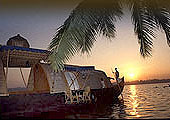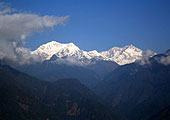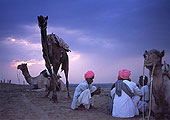01 Day: Arrival Mumbai
Welcome to India. Meeting and assistance on arrival at the Mumbai International airport, our representative welcome you and escort you by a private car and transfer to the hotel, whilst the room keys and check-in is organized, our representative would brief the tour to you and hand over the documents. Rest of your days is at leisure and free for relaxation.
Mumbai is a cluster of Seven Islands and derives its name from Mumba Devi, the patron goddess of the koli fisher folk, its oldest inhabitants. Mumbai pulsates with activity. It is a city that is disciplined by nos time frame neither day nor night. It is also the country's financial powerhouse, the nation's industrial heartland, and its economic nerve center. Dazzling shopping arcades, exciting sport activity, nightclubs & discotheques, theatre & music, gourmet restaurants and interesting sightseeing. It offers visitors a heady mix of all this and more.
02 Day: Mumbai
After breakfast takes a sightseeing tour of Bombay, drive to Gateway of India and from here cruise by motorboats to Elephanta Caves. A flight of 100 steps takes you to the top of the hill where it is set. The caves houses large pillars that seem to hold the ceiling which is made of cross beams. The picturesque presentations of the 9 marvellous sculptured panels, set on the walls are awe-inspiring. The most famous of the panels is the Trimurthi, or triple-headed Shiva, where the God is depicted as the destroyer, the preserver and the creator. Later in the afternoon cruise back to Gateway of India, one can have lunch (of your own) at the Taj Hotel or other several good Restaurants like Leopold & Mondegar serving continental cuisines. Later visit Prince of Wales Museum, Jehangir Art Gallery, Victoria Terminus, an outstanding example of Victorian Gothic Revival architecture in India, blended with themes deriving from Indian traditional architecture, Marine Drive, one of the most scenic stretches amid the concrete jungle of Mumbai.Also visit Mani Bhavan, a Gandhi Museum that houses many of his personal items and houses the same room that was used by Gandhi during his stay in Mani Bhavan, and the later visit Hanging Garden. Dhobi Ghat a fascinating spectacle, looking down on row upon row of open-air concrete wash pens, each fitted with its own flogging stone. In the evening, if time permits visit Crawford Market and then later Fashion Street or Colaba market for shopping. Return back to the hotel for overnight., Return back to the hotel for overnight.
Note: Elephanta Caves and Prince of Wales museum are closed on every Monday.
03 Day: Mumbai – Aurangabad (By Air) – Ajanta (Excursion 105 kms: 2 hrs)
Early morning check out the hotel and transfer to the airport to board the flight for Aurangabad. On arrival, transfer to the hotel. Then take an excursion to the famous Ajanta caves. Ajanta is one of the few historical and architectural marvels of India. Recognized as the World Heritage Site today, it was discovered during the 19th century by a group of British officers who were on a tiger hunt. The Ajanta group of caves, located deep within the Sahyadri hills above the Waghora, depicts the story of Buddhism that prevailed here during 200 BC to 650 AD. Ajanta’s wondrous cave temples are cut into the rocky sides of a dramatic crescent-shaped gorge, at the head of which is a waterfall that drops over the mountain rim in a series of seven steps to a pool far below –deep inside the mountain are the Buddhist chaitya – vihara prayer and monastery caves. They cover a span of 800 years where under the royal patronage of ruling dynasties, professional artists helped Buddhist monks to create magnificent murals narrating the story of Buddha in his cycle of incarnations, while simultaneously creating a painted record of the panorama of life in ancient India. Etched and painted in mineral dyes, the paintings have a languorous stylized beauty and magical eloquence. Return to back to Aurangabad for overnight stay.
Aurangabad: Malik Ambar, the Prime Minister of Murtaza Nizam Shah II, founded the city of Aurangabad in 1610 A.D, on the site of a village, Khirki. When Fateh Khan, Malik Ambar's son succeeded the throne in 1626, he named the city 'Fatehpur'. In 1653, when Aurangzeb became the Viceroy of the Deccan, he made it his capital, and renamed it Aurangabad. Maurya rule heralded the advent of Buddhism in the state of Maharashtra. The earliest caves at Ajanta and Pithalkora were excavated in the 2nd century BC, during the Satvahana era. Paithan, then known as Pratishthana, was an important trade centre at the time Aurangabad, 400 kms from Mumbai, is linked by air too. Spectacular rock cut caves and cave paintings exist at two nearby places, Ajanta and Ellora.
Ajanta: It was only in the 19th century, that the Ajanta group of caves, lying deep within the Sahyadri hills, cut into the curved mountain side, above the Waghora river, were discovered. A group of British officers on a tiger hunt, stumbled on these ancient works of art. They depict the story of Buddhism, spanning the period from 200 BC to 650 AD. The 29 caves were built as secluded retreats of the Buddhist monks, who taught and performed rituals in the Chaityas and Viharas, the ancient seats of learning, and nerve - centers of the Buddhist cultural movement.
Note: The Ajanta Caves are closed to public on all Monday and Ellora caves on Tuesday.
04 Day: Aurangabad – Ellora (Excursion 30 kms: ½ hr)
After breakfast take a sight seeing tour of Ellora, one of the highly visited World heritage sites of India. It houses 34 monasteries and temples with some exclusive uninterrupted sequence of monuments that date back from 600 to 1000 AD. The temples of Ellora are dedicated to Brahmanism, Jainism, and Buddhism. It also has some of the excellent stonework depicting the legends related to Lord Shiva. After visit return back to Aurangabad. Then visit to Bibi ka Maqbara Built by Azam Shah in 1678, the Bibi ka Maqbara is a son's loving tribute to his mother, Begum Rabia Durrani, the Queen of Mughal emperor Aurangzeb. Standing spectacularly on the lawns of the landscaped garden with ponds, fountains and water channels, the white marbled monument rises majestically in an intentional bid to copy and rival the world famous Taj Mahal of Agra and Panchakki - An engineering feat of the time is the Panchakki, or the water mill built by Malik Ambar in 1695. The water, channeled from a spring on a distant hill was used to power the flourmill and grind grain for the pilgrims. Rest of the evening is free to enjoy city atmosphere. Overnight at the hotel.
Ellora: The Ellora caves, 34 in number, are carved into the sides of a basaltic hill, 30 kms from Aurangabad. The finest specimens of cave - temple architecture, they house elaborate facades and exquisitely adorned interiors. These structures representing the three faiths of Hinduism, Buddhism and Jainism, were carved during the 350 AD to 700 AD period. The 12 caves to the south are Buddhist, the 17 in the centre dedicated to Hinduism, and the 5 caves to the north are Jain.
Note: The Ajanta Caves are closed to public on all Monday and Ellora caves on Tuesday.
05 Day: Aurangabad – Mandu (323 kms: 7 hrs)
After breakfast checkout of the hotel and drive to Mandu. On arrival, transfer to the hotel. Evening is free for leisure and relaxation. Overnight at the hotel.
The word Mandu literally means the city of joy in the local language here. Located at a distance of 99 kilometres from Indore, it is a must visit excursion point from Indore. Mandu has a number of sites to visit like the palaces, tombs, temples, and a fort that was the monsoon retreat of the Mughal emperors here. Moreover, Mandu has over 40 monuments which are divided into three broad groups: the Central Village Group, the Royal Enclave Group, and the Rewa Kund Group. Champa Baoli, the huge 15th-century Jami Masjid, the beautiful Jahaz Mahal (ship palace), the Hindola Mahal or swing palace, the romantic Baz Bahadur/’s Palace, Roopmati/’s Pavilion and the Hoshang Shah/’s Tomb are some of the unique and must see tourist spots of Mandu.
06 Day: Mandu – Indore (97 kms: 2 - 3 hrs)
After breakfast take a sightseeing tour of Mandu, the city of joy, is full of legends of love and glory, visit several noteworthy palaces and pavilions some of which are Ashrafi Mahal, Rewa Kund Group, Hindola Mahal (swinging Palace). After visit checkout of the hotel and drive to Indore. On arrival, transfer to the hotel. After some relaxation in the evening visit The Khajuri Bazaar offers you unique shopping options of gold and silver work, cloth, leatherwork and traditional garments. Famous for its glass bangles and jewellery, there are the Sarafa Market that specializes in snacks and jewellery and the Kasera Bazaar that specializes in metalwork where you can indulge in the variety displayed for selling. The Chanderi and Maheshwari silks of Indore are the other famous attractions of this city. Overnight at the hotel.
Indore:
is known as the city of the Holkars. The city was built by a Holkar Rani Ahilya Bai, one of the famous queens of India. Located in the Narmada River valley in the western part of the state of Madhya Pradesh, Indore is an important industrial city of India. It is also the centre of trade and textile industry and home to many historical monuments and temples. A must visit, Indore is also affectionately called /’Mini Mumbai/’. Visiting Indore means a visit to some of the famous historical monuments and religious centres inside the town.
07 Day: Indore – Ujjain – Indore (55 kms: 1 ½ hrs)
After breakfast take a sightseeing tour of the city visiting the Rajwada or the Old Palace (a major centre of attraction), Lalbagh palace, Kanch Mandir (a marvellous Jain temple), Chattri Bagh (the memorial with some canopies) and the Bada Ganapati (the largest lord Ganesha statue in the world). Later drive to Ujjain known for being one of the four centers of Kumbha Mela on arrival take a sightseeing tour visiting Mahakaleshwar Temple, the Gopal Mandir or the Ganesh Temple, the temple of Har Siddhi Mata (the family goddess of king Vikramaditya) and the Vedha Shala (Veda School). After visit drive back to Indore for overnight stay.
Ujjain is the modern name for Ujjayini. Legend has it that in the hoary past, the God like king Shiva of Avanti commemorated his victory over the demon-ruler of Tripura or Tripuri on the banks of the Narmada by changing the name of his capital, Avantipura to Ujjayini (one who conquers with pride).Modern Ujjain is situated on the banks of the river Shipra, regarded since times immemorial as sacred. The belief in the sacredness of Shipra, has its origins in the ancient Hindu mythological tale of churning of the Ocean by the Gods and the Demons, with Vasuki, the serpent as the rope. The ocean bed first yielded fourteen gems, then Lakshmi, the Goddess of wealth, and finally the coveted vessel of Nectar. Then began the wild scramble for immortality with the demons chasing the Gods across the skies, and in the process, a few drops were spilt, and fell at Hardwar, Nasik, Prayag, and Ujjayini. Hence the sanctity of the waters of the Shipra. Ujjain is also known for being one of the four centers of Kumbha Mela.
08 Day: Indore – Bhopal (186 kms: 4 hrs)
After breakfast checkout and drive to Bhopal. On arrival, transfer to the hotel. After relaxation take a sightseeing tour of the city visiting the Jama Masjid: Gold spikes crown the minarets of this beautiful mosque built in 1837 by Kudsia Begum. Situated at the entrance to the Chowk area in the heart of the walled city is Shaukat Mahal and Sadar Manzil: an architectural curiosity. Its mixture of styles in Occidental idioms sets it apart from the predominantly Islamic architecture of the area. Also visit the Taj-ul-Masajid is one of the largest mosques in Asia, built by Nawab Shahjehan Begum around a courtyard with a large tank in the center and with an imposing double storeyed gateway with 4 recessed archways and 9 imposing cusped multifold openings in the main prayer hall. The Quibla wall in the prayer hall is carved with 11 recessed arches, while the mimber is made of black basalt. Situated behind Shaukat Mahal on the banks of the Upper Lake is Gohar Mahal, which is an architectural gem dating back to the times of Kudsia Begum, also known as Gohar Begum, who built this sprawling palace in 1820. The Mahal is a magnificent expression of the fusion of Hindu and Mughal architecture. Evening visit the most unique national institutes in India, Bharat Bhawan is a center for the performing and visual arts. Designed by renowned architect, Charles Correa, the contours of Bharat Bhawan merge in exquisite harmony with the landscape creating a visual impact of spacious and natural elegance. Later return back to hotel for overnight stay.
Bhopal the capital city of the largest state in India, Madhya Pradesh, is also known as the City of Lakes because of the two beautiful lakes that are situated in the center of the city. Bhopal is a beautiful city also famous for its mosques. The city of lakes, Bhopal, is divided as; Old Bhopal and New Bhopal. Both the new Bhopal and the old Bhopal are contradictory to each other. One of the greenest cities of India, it has wide, clean, well-lit roads lined with fiery, tall Gulmohar trees.
09 Day: Bhopal – Sanchi – Bhopal (45 kms: 1 hr one way)
After breakfast drive to Sanchi - The ancient seat of Buddhist learning. The places worth visiting are Archaeological Museum - The most interesting pieces are the lion capital from the Ashoka pillar, a Yakshi hanging from a mango tree and a beautiful Buddha figure in red sandstone. Great Stupa - This is the finest work of art at Sanchi and amongst the finest examples of Buddhist art in India. After visit return back to Bhopal. Later evening visit Laxmi Narayan Temple And Museum, Van Vihar, Upper And Lower Lakes. Overnight at the hotel.
Sanchi is known for its Stupas, monasteries, temples and pillars dating from the 3rd century B.C. to the 12th century A.D. The most famous of these monuments, the Sanchi Stupa 1, was originally built by the Mauryan Emperor Ashoka, the then governor of Ujjayini, whose wife Devi was the daughter of a merchant from adjacent Vidisha. Their son Mahindra and daughter Sanghamitra were born in Ujjayini and sent to Sri Lanka, where they converted the King, the Queen and their people to Buddhism.
10 Day: Bhopal – Gwalior (By Train)
After breakfast check out and drive to the railway station to board the train for Gwalior. Assistance on arrival at Gwalior railway station and transfer to the hotel. After relaxation take a sightseeing of the majestic Gwalior fort is one of the largest and mightiest forts in India. Also visit Sas-Bahu Temples are 11th-century temples of Lord Vishnu while Teli-ka-Mandir is a 300-metre-high Vishnu temple of the 9th Century, visiting Jai Vilas Palace, Usha Kiran Palace, Gwalior fort, Man Mandir, Gujri Mahal and the tomb of Mohammad Ghaus. After visit return to the hotel for overnight stay.
Gwalior's legendary beginning stems from a meeting between Suraj Sen and the hermit Gwalipa, who lived on the hilltop where the fort stands. The hermit cured Suraj Sen of leprosy with a drink of water from the Suraj Kund, which still remains in the fort. Then he gave him a new name, Suhan Pal, and said his descendants would remain in power so long as they kept the name Pal. His next 83 descendants did just that but number 84 changed his name to Tej Karan and, you guessed it, goodbye kingdom.
It offers visitors a heady mix of all this and more.
11 Day: Gwalior – Datia – Orcha (135 kms: 3 hrs)
After breakfast, check out of the hotel and drive to Orcha. Enroute visit Datia its main attraction is seven storey Palace atop a hill built by Raja Bir Singh Deo. Later proceed to Orcha. The word Orcha apparently means 'hidden" it is situated on the bank of Betwa River the Bundelkhand region. On arrival, transfer to the hotel. Afternoon city tour of Orcha visiting various temple and Palaces such as Raja Ram temple, Chaturbhuj Temple, Laxmi Narayan Temple, Shiva Mandir, Panch Mukhi Mahadev Mandir and other cenotaphs " Chhatries" on the bank of river Betwa and also visit Fort Palace of Raj Mahal, Jahangir Mahal, Diwan -I- Khas and Rai Praveen Mahal. Overnight at the hotel.
Orcha: The medieval city of Orchha, in the state of Madhya Pradesh, seems to have frozen in time, its palaces and temples still retaining their original grandeur. Orchha had the distribution of being the capital of one of the largest and most powerful kingdoms of Central India. The Bundela Rajput chieftain, Rudra Pratap, founded the city, located by the side of the beautiful Betwa River, in the 16th century. The word Orchha means 'hidden'. When the Tughlaqs, who were ruling Delhi in the 15th century, pushed the Bundelkhand rajas out of Garkhundar, they retreated to distant Orcha.
12 Day: Orcha – Khajuraho (180 kms: 4 ½ hrs)
After breakfast, check out of the hotel and drive to Khajuraho. On arrival, transfer to the hotel. After relaxation explore Khajuraho, is worldly known for its magnificent temples of erotica built between 950 A.D. and 1050 A.D. Khajuraho - The very name, Khajuraho, arouses strange dreams even in daytime. Of full bodied feminine forms frozen in stone, so real that you wonder whether they might come alive at a touch. Khajuraho is world heritage town, the temples are scattered in an area of 8 sq km. After relaxation take a sightseeing tour of Western group of Temples consisting of the massive Laxman Temple dedicated to lord Vishnu, the Laxmi and Varaha temples dedicated to Vishnu’s consort Laxman, the Kandariya Mahadev temple dedicated to Lord Shiva and the Chausath Yogini temple dedicated to goddess Kali. Also visit Archaeological museum with its collection of stone sculptures of the Chandela dynasty. Overnight at the hotel.
Khajuraho The fascinating temples of Khajuraho, India's unique gift of love to the world, in the state of Madhya Pradesh, were built between 950 and 1050 A.D.It derives its name from the Khajur tree (the date palm tree) which can be found in abundance in the area. The divine sculptures in these temples are a tribute to Life itself, embodying everything that is sublime and spontaneous about it. With the wane of the Chandela Empire, these magnificent temples lay neglected, and vulnerable to the ravages of Nature. It was only in this century, that they were rediscovered, restored and granted the recognition that they justly deserve. Originally there were 85 temples, of which only 22 still exist. These magnificent temples dedicated to Lord Shiva, Lord Vishnu and the Jain Tirthankaras. The three main compartments are the entrance (ardhamandapa), assembly hall (mandapa), and the actual sanctum (garbha griha). The temples are grouped into three geographical divisions: western, eastern and southern.
13 Day: Khajuraho – Bandhavgarh (240 kms: 6 hrs)
After an early breakfast visit Eastern group of Temples and visit the Jain temples of Parsvanath, Adinath, and Shanti Nath. And the temples of Vamana and Brahma/Hanuman both dedicated to lord Vishnu. Also visit Archaeological museum with its collection of stone sculptures of the Chandela dynasty. Later checkout and drive to Bandhavgarh. On arrival, transfer to the jungle resort. After relaxation if time permits enjoy a jungle safari in the evening. Overnight at the resort.
Bandhavgarh National Park: Set amongst The Vindhya Hills in Madhya Pradesh, Bandhavgarh consists of 168 sq miles of Sal & a mixed forest with large stretches of Bamboo and Grassland to The North. One is generally lucky to view The Tiger, Gaur ( Indian Bison) Chital, Chansingha ( Four horned antelope). This Park houses some 150 species of birds including the Blue Bearded bee eaters, White Browed Fantails, and The Malabar Hornbill. The Bandhavgarh Fort , besides offering breath taking views, houses a 35 ft reclining statue of Lord Vishnu and 10th Century Rock Images of the incarnation of the Lord.
14 Day: Bandhavgarh
Early morning jungle safari by open canter. Return to the hotel for breakfast. After breakfast, trek to Bandhavgarh Fort situated at the highest point of Bandhavgarh hills. Also study the water management system. See the archaeological find of over 1000 years and study the unique topography of the Park from a birds-eye view, visit to the rural schools at Bandhavgarh. Evening recap of the day’s activity, walk through Medicinal Plant garden, study conservation practices such as solar cooking, solar water heating, vermiculture, and study the unique architecture of the Lodge, which is mud huts, and a unique Indian Village. A lecture on astronomy will follow, including stargazing with a telescope. Overnight at the resort.
15 Day: Bandhavgarh – Kanha (260 kms: 7 hrs)
After breakfast checkout the resort and drive to Kanha National Park, which is one of the most well known tiger reserves worldwide. It's located among the Banjar and Halon valleys in the Mandla / Balaghat districts. The central Kanha valley was declared a sanctuary way back in 1933 but got it's status as a National Park in 1955. It covers a large area of 1,945 square kilometers, out of which 940 square kilometers form the main park. Kanha is also famous for its animal conservation efforts made in collaboration and cooperation with the local resident communities. On arrival, transfer to the resort. Evening will be at leisure. Overnight at the resort.
Kanha's sal and bamboo forests, rolling grasslands and meandering streams stretch over 940 sq km in dramatic natural splendour which form the core of the Kanha Tiger Reserve created in 1974 under Project Tiger. The park is the only habitat of the rare hardground Barasingha (Cervus Duvaceli Branderi). By a special statute in 1955, Kanha National Park came into being. Since then, a series of stringent conservation programme for the protection of the park's flora and fauna has given Kanha its deserved reputation for being one of the finest and best administered National Parks in Asia, an irresistible attraction for all wildlife lovers and a true haven for its animal and avian population.
16 Day: Kanha
Early morning take jungle safari. Return to resort for breakfast. Later the day is free to fulfill your quest on wildlife by visiting the library, the museum and by watching wildlife presentations & movies until afternoon jungle safari. Overnight at the resort.
17 Day: Kanha – Nagpur (295kms: 7 hrs) – Mumbai (By Air)
After breakfast check out from the resort and drive to Nagpur airport to board the scheduled flight for Mumbai. On arrival at the Mumbai airport transfer to the international airport to board the connecting flight for hometown. Tour concludes here with happy memories.



















































































